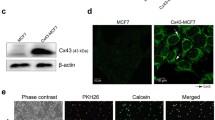Abstract
Recent studies have demonstrated that the insecticide DDT is a tumor promoting agent. Similar to many other tumor promoting agents, DDT has been shown to inhibit gap junctional intercellular communication (GJIC) between cells in culture, and it has been suggested that DDT-induced loss of communication between adjacent cells may depend on changes in cytosolic free Ca2+ concentration ([Ca2+]i). In the present study, the role of[Ca2+]i in DDT-induced loss of GJIC was investigated in WB-F344 rat liver cells using the scrape-loading/dye transfer assay (SLDT) and the Ca2+ fourescent indicator, furà-2. Our results show that DDT at non-cytotoxic concentrations caused a reversible loss of GJIC. Inhibition of GJIC was not associated with detectable increases in [Ca2+]i, and was not prevented by loading cells with the intracellular Ca2+ chelator, BAPTA. In addition, the hydroquinone, tBuBHQ, which caused a 2+3 fold sustained increase in [Ca2+]i, did not inhibit GJIC. Conversely, when untreated cells were loaded with increasing BAPTA concentrations, GJIC were lost. These results indicate that increases in [Ca2+]i are not responsible for DDT-induced loss of communication and that, in general an increase in [Ca2+]i, within physiological levels is not sufficient to abolish GJIC. However, Ca2+-dependent processes that are active at normal resting [Ca2+ i appear to be required for the maintenance of GJIC.
Similar content being viewed by others
Abbreviations
- [Ca2+]:
-
cytosolic free Ca2+ concentration
- GJIC:
-
gap junctional intercellular communication
- SLDT:
-
scrape-loading/dye transfer assay
- DDT:
-
1,1,1-trichloro-2,2-di-(4-chlorophenyl)ethane
- tBuBHQ:
-
2,5-di(tert-butyl)-1,4-benzohydroquinone
- LDH:
-
lactate dehydrogenase
- ER:
-
endoplasmic reticulum
- Fura-2:
-
1-[2-(5carboxyoxazol-2-yl)-6-aminobenzofuran-5-oxyl]-2-(2′amino-5′-methylphenoxy)-ethane-N,N,N′,N′-tetraacetic acid
- BAPTA:
-
bis-(o-aminophenoxy)-ethane-N,N,N,N-tetraaceticacid
- Fura-2/AM and BAPTA/AM:
-
are the cell permeant acetoxymethyl ester forms of fura-2 and BAPTA, respectively
References
AYLSWORTH, C.F., TROSKO, J.E., CHANG, C.C., BENJAMIN, K. and LOCKWOOD, E. (1989). Synergistic inhibition of metabolic cooperation by oleic acid or 12–0-tetradecanoylphorbol-l3-acetate and dichlorodiphenyl-trichloroethane (DDT) in Chinese hamster V79 cells: implications of a role for protein kinase C in the regulation of gapjunctional intercellular communication. Cell Biol. Toxicol. 5:27–37.
ENOMOTO, T. and YAMASAKI, H. (1985). Rapid inhibition of intercellular communication between BALB/c 3T3 cells by diacylglycerol, a possible endogenous functional analogue of phorrbol esters. Cancer Res.45:3706–3710.
FLODSTRÖM, S., WÄRNG»RD, L., HEMMING, H., FRANSSON, R. and AHLBORG, U.G. (1988). Tumour promotion related effects by the cyclodiene insecticide endosulfan studied in vitro and in vivo. Pharmacol. Toxicol. 62:230–235.
GHIASUDDIN, S.M. and MATSUMURA, F. (1981). DDT inhibition of Ca-Mg ATPase from peripheral nerves and muscles of lobster. Homarus Americanus. Biochem. Biophys. Res. Com. 103:31–37.
GRYNKJEWICZ, G., POENIE, M. and TSIEN, R.Y. (1985). A new generation of Ca2+ indicators with greatly improved fluorescence properties.J. Biol. Chem. 260:3440–3450.
ITO, N., TSUDA, H., HASEGAWA, R. and IMAIDA, K. (1983). Comparison of the promoting effect of various agents in induction of preneoplastic lesions in rat liver. Environ. Health Perspect. 50:131–138.
KASS, G.E.N., DUDDY, S.K., MOORE, G.A. and ORRENIUS, S. (1989). 2,5-Di(tertbutyl)-1,4-benzohydroquinone rapidly elevates cytosolic Ca2+ concentration by mobilizing the inositol 1,4,5-triphosphate-senstive Ca2+ pool.J. Biol. Chem. 264:15192–15198.
MADHUKAR, B.V., YONEYAMA, F., MATSUMURA, J.E. and TSUSHIMOTO, G. (1983). Alteration of calcium transport by tumor promoters, 12–0-tetradecanoyl phorbol-13-acetate and p,p′-dichlorodiphenyl-trichloroethane, in the Chinese hamster V79 fibroblast cell line. Cancer. Lett. 18:251–259.
MOORE, G.A., MC CONKEY, D.J., KASS, G.E.N., O'BRIAN, P.J. and ORRENIUS, S. (1987). 2,5-di(tert-butyl)-1,4-benzohydroquinone, a novel inhibitor of liver microsomal Ca2+ sequestration. FEBS Lett. 224:331–336.
NICOTERA, P., THOR, H. and ORRENINS, S. (1989). Cytosolic free Ca2+ and cell killing in hepatoma lclc7 cells exposed to chemical anoxia. FASEB J. 3:59–64.
PERACCHIA, C. and PERACCHIA, L. (1980). Gap junction dynamics: reversible effects of divalent cations. J. Cell Biol. 87:708–718.
PERAINO, C., FRY, R.J.M., STAFFELDT, E.E. and CHRISTOPHER, J.P. (1975). Comparative enhancing effect of phenobarbital, amobarbital, diphenylhydantoin, and dichlorodiphenyltrichloroethane on 2-acetylaminofluorene-induced hapatic tumorigenesis in the rat. Cancer Res. 35:2884–2290.
ROSE, B. and LOEWENSTEIN, W.R. (1976). Permeability of a cell junction and the local cytoplasmic free ionized calcium concentration: a study with aequorin. J. Membrane Biol. 28:87–119.
SPRAY, D.C. and BENNETT, M.V.L. (1985). Physiology and pharmacology of gap junctions. Ann. Rev. Physiol. 47:281–303.
SPRAY, D.C. SAEZ, J.C. and HERTZBERG, E.L. (1988). Gap Junctions Between Hepatocytes: Structural and Regulatory Features. In the Liver: Biology and Pathology second edition (eds Arias, I.M., Jakoby, W.B., Popper, H., Schachter, D., Shafritz, D.A.). Raven Press, Ltd, New York, pp 851–866.
SPRAY, D.C., STERN, J.H., HARRIS, A.L. and BENNETT, M.V.L. (1982). Gap junctional conductance: comparison of sensitivities to H and Ca ions. Proc. Natl. acad. Sci. USA. 79:441–445.
TUPROSKO, J.E. and CHANG, C.C. Non-genotoxic mechanisms in carcinogenesis: role of inhibited intercellular communication. In Banbury Report 31: New Directions in Qualitative and Quantitative Aspects in Carcinogen Risk Assessment (eds Hart, R. W. and Setlow, R.B.). Cold Spring Harbor Press, Cold Spring Harbor, New York, in press.
WILLIAMS, G.M., TELANG, S. and TONG, C. (1981). Inhibition of intercellular communication between liver cells by the liver tumor promoter 1,1,1-trichloro-2,2-bis(p-chlorophenyl)ethane. Cancer Lett. 11:339–344.
WHO (1979).DDT and its derivatives. Environmental Health Criteria, Vol. 9. World Health Organization, Geneva.
WARNG»RD, L., FLODSTRÖM, S., LJUNQUIST, S. and AHLBORG, U.G. (1985). Inhibition of metabolic cooperation in Chinese hamster lung fibroblast cells (V79) in culture by various DDT-analogs. Arch. Environ. Contam. Toxicol. 14:541–546.
WARNG»RD, L., FRANSSON, R., DRAKENBERG, T., FLODSTRÖM, S. and AHLBORG, U.G. (1988). Calmodulin involvement in TPA and DDT-induced inhibition of intercellular communication. Chem. Biol. Interact. 65:41–49.
YAMASAKI, H., ENOMOTO, T., MARTEL, N., SHIBA, Y. and KANNO, Y. (1983). Tumor promoter-mediated reversible inhibition of cell-cell communication (electrical coupling), relationship with phorbol ester binding and de novo macromolecule synthesis. Exp. Cell Res. 146:297–308.
Author information
Authors and Affiliations
Rights and permissions
About this article
Cite this article
Fransson, R., Nicotera, P., Wärng»ardi, L. et al. Changes in cytosolic CA2+ are not involved in DDT-induced loss of gap junctional communication in WB-F344 cells. Cell Biol Toxicol 6, 235–244 (1990). https://doi.org/10.1007/BF00249596
Issue Date:
DOI: https://doi.org/10.1007/BF00249596




